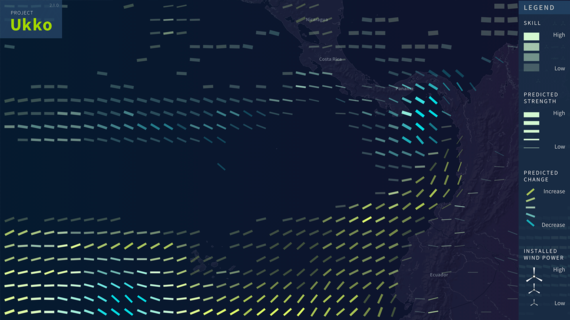It was 12 years ago I woke up to climate change. I gave up my car. 12 years of committed cycling later, I do not pretend to have balanced even my own air miles, let alone made a dent in global emissions.
Since then, significant events, such as the momentous COP21 climate summit last December have caused not only us, but the world, to rethink what our future might look like. A single number, 2 degrees, signals irreversible change for the lives of future generations.
Technology has been part of the problem. Human actions in the industrial era have shaped a new geological age and brought the world to a point of crisis. In the data age we need technology to be a part of the solution too.
I thought, I have some clever designer friends, maybe we can at least do something to help us live with the consequences of climate change.
In 2006, we started with a carbon audit of FutureEverything festival and conference, which showed that over 90% of the carbon emissions are a result of air travel by participants. So we set out to design a new kind of globally networked event with venues spread around the globe, GloNet, to see if we could deliver a comparable experience without the air miles. Then we used art installations to shift perceptions, and to generate new datasets on climate that could be useful to science.
Our first collaboration with climate scientists Climate Bubbles was an experiment in which people across the city played the bubble chase and bubble race to capture wind data, to shine a new light on the 'urban heat island' effect. Presented at our festival in Manchester, Carlo Buontempo, a climate scientist from the Met Office, had a credit as artist, and I, an artist and festival director, had a credit as weather forecaster. This was one playful way in which creative technologists set out to contribute to understanding of climate.
Hanging out with Carlo I soon developed a fascination with the science of prediction. It is becoming possible to peer further into the future. The scientific capability to predict weather and climate over months or even decades is staggering.
Climate change happens on such a big scale and over such long time periods it is hard to comprehend at human scale. But we can already see its impact in extreme weather events that are becoming more common.
Predictions of weather conditions for the coming months or season can help prepare for and adapt to extreme weather events. Our environment, health, infrastructure, food and access to fresh water are all vulnerable to variations in climate. Knowing the future is a first step to being prepared and more resilient to climate variability and change.
The problem is the recent advances in climate forecasting do not give a single certain prediction but a range of probabilities. There is a major hurdle in making the insanely complex prediction data usable for the public or businesses.

We teamed up with world leading data visualiser Moritz Stefaner and climate scientists from Barcelona Supercomputing Center and the Met Office as part of a large scale European Commission funded project called EUPORIAS. We built on the work of Barcelona Supercomputing Centre who worked with the prediction data to create a prototype climate service called RESILIENCE. Before we got to grips with the data, we spent two years working to understand the science, and the contribution design and technology could make.
The result was Project Ukko, a visualisation interface to explore future wind conditions, named after the Finnish god of the sky, weather and thunder. This presents a new way to look at complex prediction data, and equips wind energy professionals to manage future weather events.
Moritz designed the visualisation, a global map with a data overlay, designed to enable wind energy professionals to quickly spot global patterns and trends in future wind conditions, and then drill into detailed predictions. Line symbols visualise the wind prediction data, predicted wind speed represented in line thickness, predicted change in tilt and colour, and prediction skill in the transparency of the line. A design element we call a prediction cone presents to viewers the full range of probabilistic forecasts behind each line.
In the wind energy sector it is crucial to understand wind conditions in the next few months. The interface can be used to explore future wind farm power output, and locate regions likely to see high or low wind speeds or substantial fluctuations.
Climate change poses an urgent challenge to rethink of the ways in which we manage the resources of the planet, and new ways to extract meaningful information from data can help.
We launched Project Ukko as a part of this year's FutureEverything festival, in Manchester, which ran from 30th March to 2nd April. The festival looked at resources in a whole new way asking how life, intelligence, the Earth, community and uncertainty can be used as resources, often in unexpected ways.
Project Ukko is a FutureEverything and Barcelona Supercomputing Centre project for EUPORIAS with visualisation design by Moritz Stefaner, Project Director, Drew Hemment, it was presented as a part of European City of Science at the FutureEverything festival.
EUPORIAS is a project funded by the EU 7th Framework Programme (GA 308291) and led by the Met Office.
